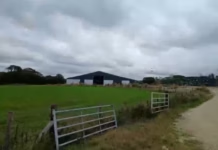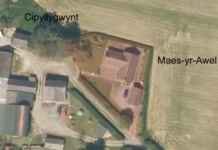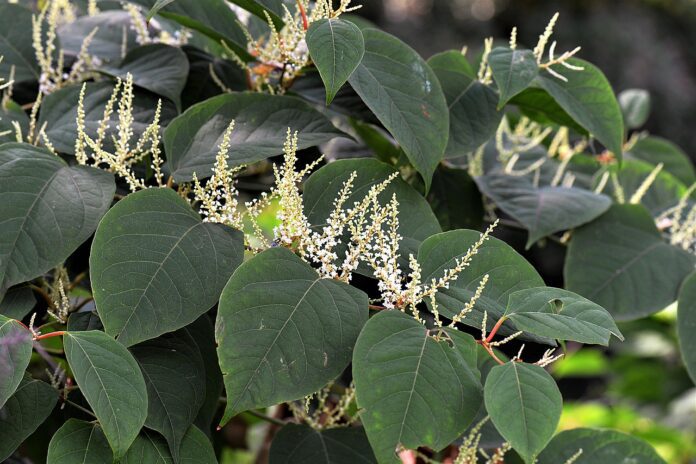Discovering knotweed on your property can be a cause for concern, but with the right approach, you can effectively address this invasive plant and prevent it from taking over.
In this comprehensive guide, we’ll provide you with a step-by-step plan on what to do if you find knotweed at your home and how to eradicate knotweed to regain control of your outdoor space.
Step 1: Confirm the Identification
When you suspect you have knotweed, the first critical step is to confirm the plant’s identification. Knotweed, scientifically known as Fallopia japonica, is distinguishable by several key features:
- Stems: Knotweed’s stems resemble bamboo, growing upright and can reach heights of up to 10 feet. They have hollow interiors and often exhibit reddish-purple speckles.
- Leaves: Knotweed leaves are heart-shaped, broad, and alternate along the stems. They are typically dark green in color.
- Rhizomes: One of the most defining characteristics of knotweed is its underground rhizome system. These reddish-brown rhizomes can extend several feet horizontally and vertically.
It’s essential to correctly identify the plant to ensure you’re dealing with knotweed, not a harmless look-alike.
Step 2: Document and Mark the Infestation
Once you’ve confirmed the presence of knotweed on your property, document its location and mark the affected areas. This documentation serves multiple purposes:
- Tracking Progress: Recording the infested areas allows you to track the extent of the infestation and assess the effectiveness of your eradication efforts over time.
- Preventing Accidental Spread: By clearly marking the boundaries of the infested areas with flags or stakes, you can prevent accidental disturbance or spread of knotweed to other parts of your property.
Step 3: Develop a Knotweed Management Plan
Creating a well-structured knotweed management plan is crucial for effective eradication. Your plan should encompass the following components:
- Identification of Treatment Methods: Decide whether you’ll use chemical control, mechanical control, or a combination of both based on the severity of the infestation and your preferences.
- Herbicide Selection: If you opt for chemical control, carefully choose a herbicide containing glyphosate or triclopyr, as they have been proven effective against knotweed.
- Timing: Determine the optimal time for treatment. Knotweed is most vulnerable during its active growth phase in late spring or early summer when it’s transporting nutrients from the leaves down to the rhizomes.
- Safety Precautions: Ensure you follow safety guidelines when handling herbicides and use appropriate protective gear to protect yourself and the environment.
Step 4: Chemical Control
Chemical control is one of the most effective methods for knotweed eradication. Here’s how to proceed with chemical control:
- Apply Herbicide: Spray the selected herbicide on the knotweed leaves during the active growth phase. Be thorough but avoid excessive runoff, as you want the herbicide to be absorbed effectively.
- Multiple Applications: Recognize that knotweed may require several herbicide applications over a few years for complete eradication. Maintain a schedule and closely monitor the progress to ensure the plant is effectively managed.
Step 5: Mechanical Control
Mechanical control methods involve physically removing knotweed from your property. Follow these steps for mechanical control:
- Cutting Stems: Start by cutting down the knotweed stems to the ground. This reduces its ability to photosynthesize, weakening the plant.
- Digging Out Rhizomes: Carefully dig out the rhizomes as deeply as possible, as they can extend several feet horizontally and vertically into the soil. Be thorough in your excavation to prevent regrowth.
- Dispose Properly: Properly dispose of the removed plant material. Burning or sending it to a landfill are suitable disposal methods. Do not compost knotweed, as it can regenerate from even small rhizome fragments.
Step 6: Regular Monitoring and Maintenance
Regular monitoring is essential to prevent knotweed from returning even after successful control efforts. Follow these maintenance guidelines:
- Inspect Regularly: Conduct periodic inspections of the marked areas for any signs of regrowth or new shoots.
- Reapply Herbicides: If you used chemical control, be prepared to reapply herbicides to prevent a resurgence of knotweed. This may be necessary for several years.
- Prevent Spread: Take precautions to avoid spreading knotweed to new areas. It can propagate from even small rhizome fragments, so exercise caution when working in infested areas.
Conclusion
Finding knotweed at your home can be daunting, but with a systematic approach and persistence, you can effectively eradicate it and protect your outdoor space. Correctly identifying the plant, documenting the infestation, and developing a comprehensive management plan are crucial initial steps. Whether you choose chemical or mechanical control methods, regular monitoring and maintenance will be key to long-term success.
In summary, knowing what to do if you find knotweed and how to eradicate knotweed is vital for preserving the beauty and health of your garden and landscape. Following this step-by-step guide will enable you to tackle this invasive plant and regain control of your property, ensuring a knotweed-free future for your outdoor space.

| [donate]
| Help keep news FREE for our readersSupporting your local community newspaper/online news outlet is crucial now more than ever. If you believe in independent journalism,then consider making a valuable contribution by making a one-time or monthly donation. We operate in rural areas where providing unbiased news can be challenging. |



















